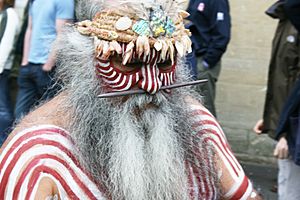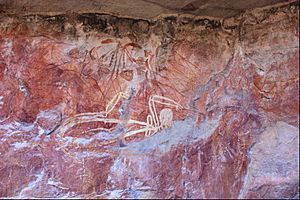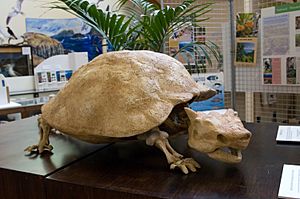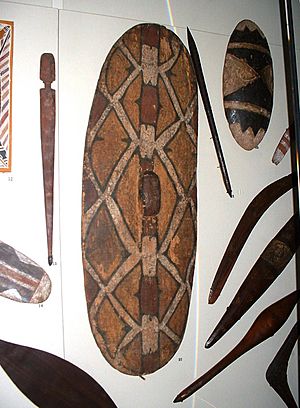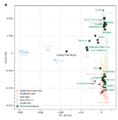Ancient Australia facts for kids
Ancient Australia is about the time from when the first people arrived in Australia. This period lasted until the First Fleet came in 1788. Scientists have found old tools and items on Rottnest Island. These items show that people lived there between 6,500 and 30,000 years ago. Even newer findings suggest humans were in Australia 50,000 years ago, or even earlier.
Contents
History of Early Australians
During the Pleistocene period, also known as the Ice Age, sea levels were much lower. This made it easier for people to travel from Asia to Australia. But they still had to cross some long stretches of ocean. Around 8,000 years ago, rising sea levels covered the land bridge between Australia and New Guinea.
Scientists have studied the DNA of the native people of Australia and New Guinea. This research shows they are closely related. The DNA also tells us that Aboriginal Australians are part of a group of modern humans. This group left Africa between 50,000 and 70,000 years ago.
Research also shows that Aboriginal Australians left Africa about 24,000 years before groups that settled in Europe and Asia. This makes them one of the oldest native peoples outside Africa. The DNA also suggests that most migration to Australia stopped around 50,000 years ago. After that, the people in Australia developed separately from the rest of the world. The Aboriginal Australian population has one of the oldest continuous cultures on Earth.
Who Were the First Australians?
We don't know exactly what the first Australians looked like. The oldest known place where humans lived in Australia is the Malakunanja II rock shelter. It is in the Northern Territory and dates back 55,000 years. The oldest human remains found in Australia are at Lake Mungo in New South Wales. These remains are about 15,000 years younger than the rock shelter.
Bones from people who lived between 40,000 and 10,000 years ago show they were very strong. They also had more physical differences than people who came later. Important places like Lake Mungo, Kow Swamp, and Keilor tell us a lot about these early people.
The first Australians had dark skin and black hair. Most of them were hunter-gatherers. This means they hunted animals and gathered plants to eat. They were also nomadic people, moving from place to place to find seasonal foods. Over time, they formed different ethnic groups. Each group had its own language and traditions.
In 1788, there were about 500 different language groups in Australia. Each language group had many smaller family groups. These smaller groups often met for special ceremonies and trade. Because they were all so different, it's hard to make general statements about all Aboriginal traditions and beliefs.
Fire and Changing Landscapes

Old ash layers found in the Coral Sea show that fire was common in Australia over 100,000 years ago. Over the last 70,000 years, fires happened more often. One reason for this is that hunter-gatherers used fire as a tool. They used it to hunt animals, to make new plant growth, and to clear thick forests.
Because of these fires, thick forests became more open woodlands. Open woodlands turned into grasslands. Plants that could survive fire, like eucalyptus, acacia, and grasses, became more common.
The changes to animals were even bigger. Many very large animals, called Megafauna, disappeared. Many smaller animals also became extinct. About 60 different vertebrate animals died out. These included the Diprotodon family, which were huge marsupials that looked like hippos. There were also large flightless birds, meat-eating kangaroos, a five-metre lizard, and Meiolania. This was a tortoise the size of a small car.
We are not sure why these megafauna became extinct. It might have been fire, hunting, climate change, or a mix of all these things. Without large plant-eating animals, there was more dry plant material. This made fires burn hotter, changing the land even more. However, there is also evidence that Aboriginal people used careful, seasonal fires. These fires helped reduce fuel, stopping bigger wildfires like those seen after Europeans arrived.
Between 18,000 and 15,000 years ago, Australia became drier and colder. Then, between 16,000 and 14,000 years ago, sea levels rose very quickly. One scientist thinks the sea level rose 50 feet in just 300 years.
At the end of the Pleistocene period, about 13,000 years ago, rising sea levels cut off land access. This happened across the Torres Strait to New Guinea. It also happened across the Bass Strait between Victoria and Tasmania, and to Kangaroo Island.
From that time on, the Aboriginal people of Tasmania were cut off. By 9,000 years ago, small islands in Bass Strait and Kangaroo Island were no longer lived on.
Studies of language and genes show that people in northern Australia had contact with people from New Guinea and nearby islands for a long time. This was mostly through trade, with some intermarriage. Macassan praus (boats) are also mentioned in Aboriginal stories. These stories come from places like Broome to the Gulf of Carpentaria. Some small settlements were even set up, and some Aboriginal people found homes in Indonesia.
Aboriginal Culture
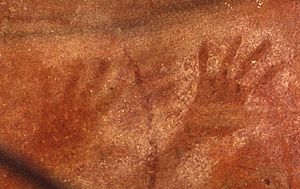
Aboriginal people did not have a writing system. Instead, they painted pictures on rocks and bark. They also carved designs into rocks. They made paints from crushed rocks and water. These paints came in colors like brown, red, orange, and yellow.
Many ancient cave paintings can be found all over Australia. The paints were made from crushed rock and clay, so they are not organic. This means we cannot use carbon dating to find their exact age.
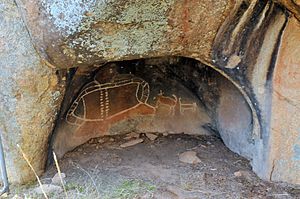
Some paintings show megafauna that became extinct over 40,000 years ago. These might be the oldest known paintings in the world. Another site in Arnhem Land has charcoal drawings. These have been dated to be 28,000 years old using radiocarbon dating.
Aboriginal people have no stories or memories of living anywhere outside Australia. However, people living along the northern coast, in places like the Kimberley and Cape York, met visitors for thousands of years.
People and goods moved freely between Australia and New Guinea. This continued even after the land bridge was covered by rising sea levels about 6,000 years ago.
Aboriginal people have strong spiritual beliefs. They believe that everything came from the Dreamtime. They also believe the Earth is sacred. They think that ancestor spirits, like the Rainbow Serpent, created the world. The rules and customs of the Dreamtime are passed down from parents to children. They have special songs and dances that are performed at corroborees.
Images for kids
See also
 In Spanish: Prehistoria de Australia para niños
In Spanish: Prehistoria de Australia para niños



